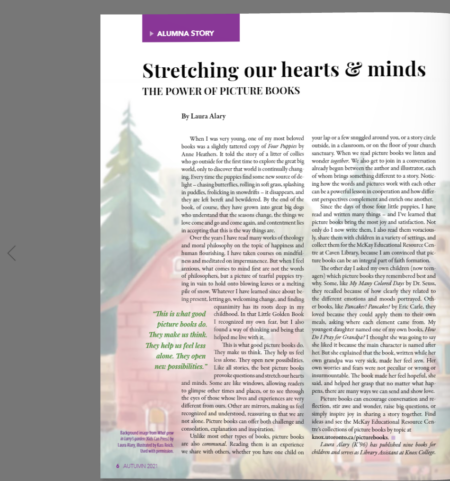Stretching our hearts & minds: the power of picture books
This article appears in Vocations magazine (pictured at right), Autumn 2021. Read this article in the magazine online or download the PDF. To subscribe, click here.
By Laura Alary
When I was very young, one of my most beloved books was a slightly tattered copy of Four Puppies by Anne Heathers. It told the story of a litter of collies who go outside for the first time to explore the great big world, only to discover that world is continually changing. Every time the puppies find some new source of delight – chasing butterflies, rolling in soft grass, splashing in puddles, frolicking in snowdrifts – it disappears, and they are left bereft and bewildered. By the end of the book, of course, they have grown into great big dogs who understand that the seasons change, the things we love come and go and come again, and contentment lies in accepting that this is the way things are.
Over the years I have read many works of theology and moral philosophy on the topic of happiness and human flourishing. I have taken courses on mindfulness and meditated on impermanence. But when I feel anxious, what comes to mind first are not the words of philosophers, but a picture of tearful puppies trying in vain to hold onto blowing leaves or a melting pile of snow. Whatever I have learned since about being present, letting go, welcoming change, and finding equanimity has its roots deep in my childhood. In that Little Golden Book I recognized my own fear, but I also found a way of thinking and being that helped me live with it.
This is what good picture books do. They make us think. They help us feel less alone. They open new possibilities. Like all stories, the best picture books provoke questions and stretch our hearts and minds. Some are like windows, allowing readers to glimpse other times and places, or to see through the eyes of those whose lives and experiences are very different from ours. Other are mirrors, making us feel recognized and understood, reassuring us that we are not alone. Picture books can offer both challenge and consolation, explanation and inspiration.
Unlike most other types of books, picture books are also communal. Reading them is an experience we share with others, whether you have one child on your lap or a few snuggled around you, or a story circle outside, in a classroom, or on the floor of your church sanctuary. When we read picture books we listen and wonder together. We also get to join in a conversation already begun between the author and illustrator, each of whom brings something different to a story. Noticing how the words and pictures work with each other can be a powerful lesson in cooperation and how different perspectives complement and enrich one another.
Since the days of those four little puppies, I have read and written many things – and I’ve learned that picture books bring the most joy and satisfaction. Not only do I now write them, I also read them voraciously, share them with children in a variety of settings, and collect them for the McKay Educational Resource Centre at Caven Library, because I am convinced that picture books can be an integral part of faith formation.
The other day I asked my own children (now teenagers) which picture books they remembered best and why. Some, like My Many Colored Days by Dr. Seuss, they recalled because of how clearly they related to the different emotions and moods portrayed. Other books, like Pancakes! Pancakes! by Eric Carle, they loved because they could apply them to their own meals, asking where each element came from. My youngest daughter named one of my own books, How Do I Pray for Grandpa? I thought she was going to say she liked it because the main character is named after her. But she explained that the book, written while her own grandpa was very sick, made her feel seen. Her own worries and fears were not peculiar or wrong or insurmountable. The book made her feel hopeful, she said, and helped her grasp that no matter what happens, there are many ways we can send and show love.
Picture books can encourage conversation and reflection, stir awe and wonder, raise big questions, or simply inspire joy in sharing a story together. Find ideas and see the McKay Educational Resource Centre’s collections of picture books by topic at knox.utoronto.ca/picturebooks.
Laura Alary (K’96) has published nine books for children and serves as Library Assistant at Knox College.
This article appears in Vocations magazine, Autumn 2021. Read this article in the magazine online or download the PDF. To subscribe, click here.

